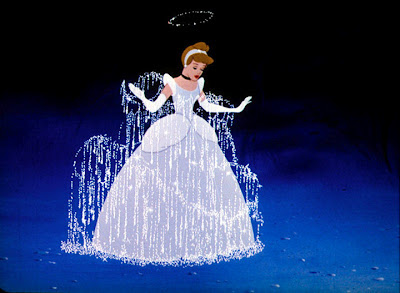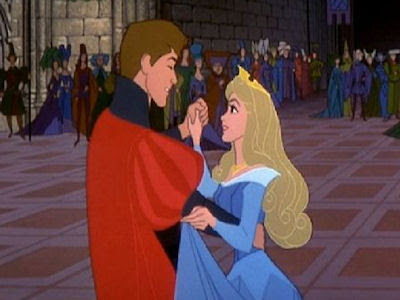If you give a meandering mouse a cookie, she will accept it, eat it, and be grateful. The end.
If you give a meandering mouse an inch of thought, she will take it and run as far as she can. Not the end.
A thought which has been unspooling in my head lately has to do with “people” who are familiar to most of you reading – Snow White, Cinderella, and Sleeping Beauty as interpreted by Walt Disney’s team of artists.
Many critics decry the main impetus of their stories – happily ever after doesn’t come unless a prince falls in love with you. Many counter-critics insist that these stories are classics to this day because women are hard-wired to desire domestic stability.
I just want to talk about their clothes.
No one in medieval times ever dressed like Snow White. What is with the bare arms and the pumps with the little bows on them? And no head covering?
When contemporary creators make historical worlds, they know their audience is people alive today, not those alive then. If one wrote a historical romance set in the American South before the Civil War, the heroine and hero had better be against slavery – or at least change their minds by the last page – or no mainstream publisher, large or small, will touch the book. This is also why Snow White appears as if she could easily rub shoulders with Andy Hardy in Carvel.
Next is Cinderella (my personal favorite, BTW). What year is this movie set in, anyway? Lady Tremaine (the stepmother, to non-Disney fans) wears mutton-leg sleeves from the first decade of the 20th century, while her daughters Druzilla and Anastasia sport giant trailing bustles from the 1870s.
At home, Cinderella wears a simple dress whose length (or should I say shortness?) would have been considered obscene until the 1920s. When the Fairy Godmother comes around, what have we here?
Have you ever seen anyone wear a dress that looks like this in any time period? (No, seeing Cinderella at any of the Disney parks does not count.)
On to Sleeping Beauty. Although her tale appears to be firmly set in medieval times, the dress she wears in the forest is anachronistically short.
When she gets into princess gear, just like Cinderella she has a fairy-tale-cum-Jetsons motif.
And it’s blue – most of the time.
When Sleeping Beauty reappeared as a founding member of the Disney Princess lineup, her dress is pink. Why? So Cinderella’s dress could be blue – unlike in the movie, where it is white. Or perhaps silver. (FYI, that is one unflattering blue – Cinderella, of all people, deserves much better.)
What does the attire of fictional princesses have to do with the way the world turns? Not much. Still, it’s something I have to think about.
Why? Because the meandering mouse mind moves in mysterious ways – and also dreams of wearing pretty dresses, even if they are out of time. (My prince has already come.)
Friday, June 29, 2012
Monday, June 25, 2012
More good old books to enjoy

The previous post about Going Down with Janis got me thinking about some more oldy-but-goody books that are well worth reading this summer. Here is a list of other books that are at least thirty years old which are well worth a summer read. (Note: the dates are the years of original publication; some of these books were reissued years later. If you look for these books online, search by title and author and pay no attention to the year.)
1. Valley of the Dolls, Jacqueline Susann (1966) – This is not the original potboiler (I think that title goes to Peyton Place), but it stands on the mountaintop (not the valley) of just-for-fun adult reads. (Don’t forget to watch the movie before summer’s end, too!)
2. Hell’s Angels, Hunter S. Thompson (1967) – This is as close to the Hell’s Angels as most of us – the folks with common sense, that is – will want to get.
3. Airport, Arthur Hailey (1968) – This is the kind of book you don’t see any more – human drama blended with education. Read Airport, and you will not only read a meaty story with adultery, hijacking, and lingering guilt, but a behind-the-scenes look at a metropolitan airport (the way it was in 1968). I like this kind of book – I’m currently reading Frank G. Slaughter’s Doctors’ Wives in my bathroom.
4. Coffee, Tea, or Me, Trudy Baker and Rachel Jones (1969) – The heyday of airplane travel, when all of the flight attendants were cute girls and you actually looked forward to getting on that plane. Even the revelations in the 2003 reissue do not subtract from the magic of the narrative. You haven’t lived until you’ve read the list of what men of various nationalities are (supposedly) like.
5. Portnoy’s Complaint, Phillip Roth (1969) – This is considered a literary novel, and it almost doesn’t belong on this list – except for the laugh-out-loud moments such as the discovery of the other use for liver.
6. The World of Star Trek, David Gerrold (1973) – You don’t need to be a Trekker to get something out of this book – namely, greater understanding of what makes a great television show (hint: it’s the writing) and how even this classic could have been better (hint: less danger, more decisions).
7. Judy, Gerold Frank (1975) – This is one of the handful of Garland biographies which does not play a one-note “poor, poor pitiful Judy” song. Seriously, if you want to read a downer this summer, pick George Orwell’s 1984.
8. (The People’s Almanac Presents) The Book of Lists, Irving Wallace, Amy Wallace, David Wallechinksky (1977) – Yes, this book has been reincarnated over the years, but you must read the original, if only to feel like a naughty twelve-year-old again when you see the “Top Ten Sexual Positions” list (“doggie-style”, huh huh huh huh).
9. Hollywood is a Four-Letter Town, Made in Hollywood, James Bacon (1977, 1978) – A tiptoe through the oversaturated garden of delights that was “old” Hollywood, courtesy of an Los Angeles Herald-Examiner columnist (remember that paper?) It’s…well, it’s like TMZ on paper, minus all of those people who you never freaking heard of.
Wednesday, June 20, 2012
Summer reading; Going Down with Janis

Today is the first day of summer. No matter where you are right now, from lounging next to a pool from plowing through hump day work, please understand the importance of this day. It is the starting line of fun, fun, fun, at least until your daddy takes the T-Bird away.
But what if you don’t have a T-Bird? Don’t worry - your good friends the books will take you places. Yes, you can look to the New York Times and NPR and Oprah to figure out what you should be reading this summer. I have a feeling, though, that you won’t enjoy those books half as much as you will Going Down with Janis by Peggy Caserta (as told to Dan Knapp).
This was my first adult summer book. I’ve got a little story about that.
Imagine the middle of June of 1981. High noon. It is bright outside, as if we were living inside the sun instead of millions of miles away, and sticky hot – the kind of hot that glues clothes and skin together. The kind of hot that commands something cold to drink, and not water but a chilly bottle of Coke. The kind of hot that was welcome on the last day of school.
The public library was right across the street from the bus stop where I got off on the way home. I stepped in and went right to the 780 section (which in the Dewey Decimal System means music), looking for a reward for months of dutiful schoolwork.
One book stood out immediately – a book painted an almost fluorescent green. Today, almost all books in the library have their original covers wrapped in plastic, but in 1981 it was common for older books to be coated in several layers of paint, with the title stamped on the spine.
I opened the book, and the contents were as – how should I put this – as colorful as the green cover. This is the first line of the book, and it has become a classic when it comes to rock biography - heck, biography of any kind.
I was stark naked, stoned out of my mind on heroin, and the girl lying between my legs giving me head was Janis Joplin.
Oooh, I just had to read this. I checked it out, took it home, and got more of the same: more sex, more drugs, more rock, plus nuggets of violence, illegal abortion, portable toilets with pyramids of feces, and Lee Harvey Oswald. In other words, places that fifteen-year-old me wasn’t going to visit in person any time soon. Better yet, it was salted with language as saturated as one of those black-light ready posters advertised in the back pages of rock magazines such as Creem:
But not tonight. The heroin had seen to that. GoodGodMotherfucking Queen Smack. For all we knew, the sheets we were floating on could have been liquid gold. Over in the corner on a table, the light from a cheap plastic lamp had been transformed into a beneficent minor sun, warming our brittle bones and transporting us to some pestless place where the temperature and humidity were eternally right.
Get your hands on Going Down with Janis this summer, and I can guarantee you that you will just enjoy it more than any book on this year’s “recommended” lists. And don’t wait until fall; this book almost requires sunshine and cold soda.
Now, I can hear the literalists out there asking this question: “Was the story true?”
Who knows, except Ms. Caserta herself? More to the point, is truth necessary to enjoy this book? No more than it would be with, say, a book of fantasy or futuristic fiction.
I am going to start re-reading Going Down with Janis today, and in a future post let you know what I think about it now. Perhaps I will enjoy it as much as I did thirty-one years ago. Perhaps I will feel ashamed - this may be a story which requires more scoops of compassion than pinches of delight. Perhaps the story of one woman’s slippery slide down the path to a heroin overdose is not the most entertaining one since The Wizard of Oz.
But that’s a story for another summer day.
Subscribe to:
Posts (Atom)









